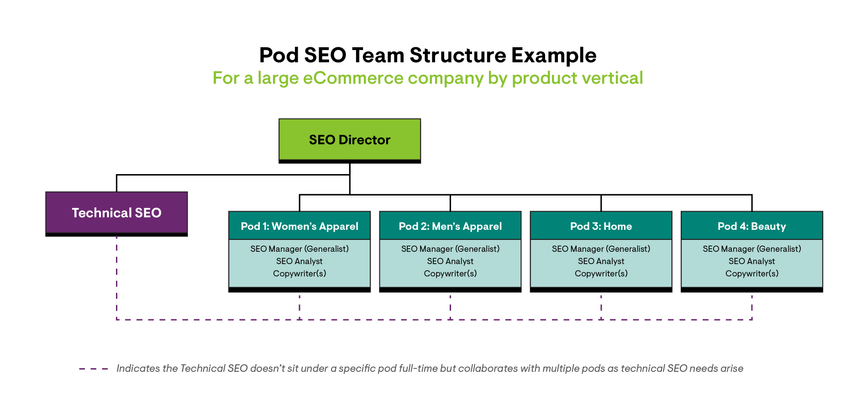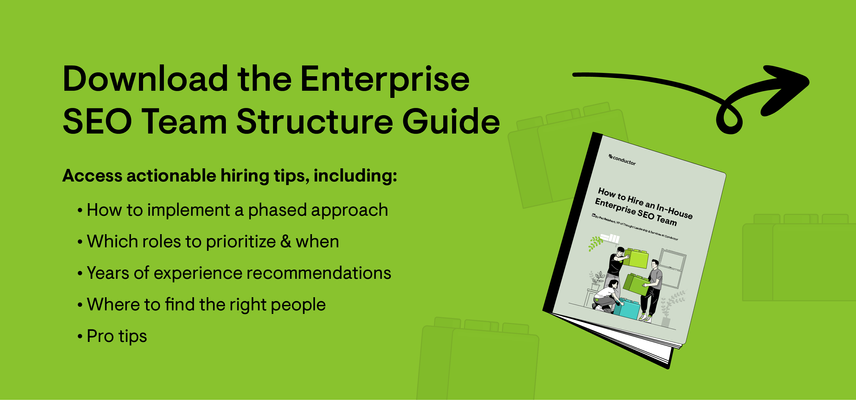How to Build and Structure an Enterprise SEO Team
The biggest enemy of enterprise SEO success isn’t an algorithm; it’s disorganization.
The only way to overcome it is to identify and implement the right in-house SEO team structure mapped to your needs.
Then, with the help of your SEO leader, follow a phased approach to hiring that maximizes resource allocation and sets the program up for scalable success.
One question I get asked all the time from our customers is how to structure an enterprise SEO team for success. Organizations focused on building an effective and scaleable SEO program want to know how an ideal team is organized, how big it has to be, and which positions to hire first.
That’s because successful enterprise SEO depends on hiring the right experts and identifying the right team structure to enable centralized processes. Today’s enterprise SEOs and marketers must compete with smaller companies that can move much faster due to less red tape. As a result, the best enterprise teams prioritize efficiency, agility, and a cross-functional approach.
While there isn’t a one-size-fits-all answer, our customers have found the highest probability of success with the following strategic, intentional, and phased approach. (Spoiler: it takes time, but if you’re willing to put in the effort, then it will transform your digital growth potential.)
The biggest challenge of building an enterprise SEO team
One of the hardest things about building an enterprise SEO program—or any SEO program—is getting buy-in. Before you do anything, you have to obtain buy-in from the powers that be within your company to make sure they understand the importance of this channel and why they should invest in it.
Ultimately, if you don’t have the buy-in, you won't get the level of investment you need, and everything I’m about to cover will become a wasted effort and an unfruitful uphill battle.
Check out our Enterprise SEO Challenges Guide for proven solutions from top SEO experts on overcoming roadblocks, educating leaders, and securing the buy-in you need.
How to build a successful enterprise SEO team: Proven best practices
1. Organization should be your primary goal.
Given the nature of Google’s algorithm, SEO is best known for its unpredictability and rapid state of change. However, you’ll likely be surprised to hear that the biggest enemy of enterprise SEO success isn’t an algorithm; it’s disorganization. Other SEO experts may recommend infinite freedom for SEO teams to foster innovation and adapt to the changing landscape. Still, the reality is that the most successful SEO programs are mechanical.
What I mean by mechanical is that SEO is an inherent part of any process that touches the websiteWebsite
A website is a collection of HTML documents that can be called up as individual webpages via one URL on the web with a client such as a browser.
Learn more, so there needs to be technological infrastructure in place to ensure this is the case. While not an exciting description, the truth is that large-scale SEO programs have a lot of moving parts. If those parts are disorganized or disconnected, they will wind up working against one another rather than in unison. (Think: longer lengths of time to implement content changes and resolve technical issues; irregular and disorganized or fragmented reporting, etc.)
When all of these parts are working in concert with one another, that gives the SEO lead the ability to conduct activities at scale and move the program forward because they have the right people working on the right things in a consistent manner.
2. Start small and implement a phased approach
While I would love to tell you that you’re going to walk into your boss's office, dictate your dream headcount needs to manage your SEO program and walk out happy, the reality is you’re going to have to start small and build up over time through a phased approach.
One of the most prevalent myths in enterprise SEO is thinking that because your company is big, you need an equally large SEO team to be successful. I’m here to tell you it’s simply not true. Typically, you need a few specialized folks with the right support to keep the program moving forward and have the bandwidth to innovate, integrate automation, and implement the right processes within your organization to deliver long-term, scalable success.
While many enterprise companies still have fractional resources dedicated to SEO, the ones that understand the importance and opportunities of the channel know the best way to sustain and grow their programs is by investing in these resources. Implementing a phased approach ensures you’re maximizing your investments in the roles that will drive the most impact while mitigating common hiring mistakes caused by moving too fast.

3. Determine the best SEO team structure
Once you’ve onboarded your primary SEO leader, the next step of the process should be collaborating to determine the best SEO team structure based on your specific business needs and organizational structure. Your enterprise SEO team structure should complement your business model.
Start by outlining your goals for the SEO program and build for the outcome. What do you want to achieve one year, three years, and five years from now? Where are your biggest areas of opportunity? What are the most significant challenges you’re currently facing? What are your largest SEO skills gaps at the moment?
If you don’t know the answers to these questions, that’s okay. Your initial focus should be on recruiting and hiring an SEO leader who can help you identify the right questions to ask. They can also recommend or develop a team structure option that facilitates optimal collaboration between departments, which is especially important as your goal should be to integrate SEO as a critical step in most internal processes involving web development, engineering, creative, content, product, and digital-focused teams.
4. Trust your SEO leader’s instincts
This best practice is key. The entire goal of building and structuring your SEO team is to put the right people in the right positions to do what they do best. To do that, you have to trust your SEO leader and rely on their recommendations, instincts, and experience. Empower them to take the reins when it comes time to expand the team.
Without that trust, you’ll end up with a disorganized team, high turnover, and competing or confused SEO priorities that will not produce the results you’re after and will prevent you from scaling successfully.
Where should an enterprise SEO team sit?
Before diving into SEO team structure types, let’s tackle another common question from our customers: where should SEO sit?
Unlike other marketing or digital strategies, SEO relies on significant collaboration between multiple teams within an organization. So, you need to be strategic on where to house this team to ensure they are set up to collaborate effectively, move fast, and get the proper support or prioritization when needed.
Where SEO should sit within the company org chart:
- Marketing Team: SEO, at its core, is a marketing function, and there is an argument to be made that they should sit with your demand gen teams as they are a growth function.
- Web Team: At many organizations, this is the team that owns the website and all of its goings-on. While not directly on the marketing team, they are adjacent to it. There is value in having close proximity and daily collaboration between developers, engineers, and SEOs from a technical SEO and website optimization perspective.
- Product Team: This team is responsible for product, related web design, and go-to-market strategy. Having SEO sit under this team helps ensure SEO is prioritized within the product and website messaging development process from the start. It also means you’ll have an easier time accessing engineering resources.
- Or Growth Team: Many organizations have a team that is dedicated to growth, and SEO can fit underneath this banner. While adjacent to the broader marketing team, this team typically has a leader who reports directly to the CMO.
Where SEO should not sit:
- IT: IT is where SEO teams go to die. Do not, under any circumstances, let the SEO team sit underneath your IT team. While at first, this may make sense given the technical nature of some SEO functions, the SEO team's responsibilities and budget extend well beyond the technical aspects of your site, and allowing them to sit underneath an IT-focused leader here will result in anemic results and a revolving door of talent.
Set up for success: Core departments enterprise SEO teams should collaborate with
Another essential consideration in informing team structure is thinking through which departments the SEO team will collaborate with most often.
SEO is a practice that spans many aspects of your business, so you will have to plan to accommodate some changes in responsibilities to allow your team the autonomy they need to succeed.
- Marketing: Regardless of whether the SEO team sits directly with the marketing department or not, they should have a direct line of communication with this group as any content added, modified, or changed to/on the website needs to be clearly communicated beforehand as it can directly impact various elements of your SEO initiatives.
These teams need to be in lockstep with one another to ensure that everyone is aligned on the direction of the site and nothing is being done without the SEO team's knowledge. - IT: One of the most important relationships that needs to be formed early on within your organization is the one between your IT and SEO teams. The reason is not solely from a technical perspective but from an implementation standpoint.
Your SEO team will need things added to the site regularly, and the IT team is most often the gatekeeper to the technical side of the site. Implementation is the most significant hurdle in SEO, so a healthy relationship between these two teams is critical to the success of your program. - Content: The most important piece of any SEO strategy is the creation and optimization of content. The folks within your organization who create or outsource content creation need to be fully aligned with the SEO program’s goals and initiatives for it to be successful. In most cases, those responsible for content will need to upskill in the practice of SEO themselves. The reason for this goes back to the comment I made earlier about SEO becoming mechanical.
The best way to do that is by making it part of everyone’s day and building it into cross-functional internal processes, not just the SEO team’s. - Leadership: While this may seem like a curious call out, the fact of the matter is that in order for your SEO program to flourish, you need continued buy-in from above. The leadership team needs to be looped in on what your SEO team is doing to understand the impact and value so they continue to invest year after year.
A key responsibility for your SEO Director is to report up and ensure that leadership understands what is happening and what is changing while also setting proper expectations and drawing a clear connection to the results.
Enterprise SEO team structure examples to consider
Identifying the proper SEO team structure comes down to your type of business; what works for a large eCommerce company won’t work for a B2B SaaS brand.
There are three common enterprise SEO team structures to consider: hierarchical, pod, and brand/product/vertical/market. For project-based work, all organizations—regardless of vertical, audience, or product offering—can and should leverage the adaptive triad approach to enable effective collaboration across multiple departments that sit outside a typical SEO team.
Here’s a brief overview of those three team structure types, along with the adaptive triad approach, and what they look like in practice.
1. Hierarchical structure
This in-house SEO team structure type follows the traditional hierarchy approach. This option often has SEO teams operating as a fully independent team or as a sub-group within the marketing department.
You’ll note the visual below doesn’t include implementation roles like engineers. While these roles collaborate with SEO, they typically don’t report directly to the SEO team in this structure.

A hierarchical structure encourages and prioritizes specialization. This is helpful if there are specific areas of focus where the organization would benefit from having highly skilled subject matter experts, like content SEO and technical SEO, for example.
Additionally, it can increase efficiency by helping leaders and managers delegate tasks accordingly and ensuring team members know who to turn to for answers, progress updates, or reporting issues. You can also unlock more effective collaboration with this structure as it provides clearly defined roles and a chain of command.
A critical element to prioritize if you opt for the hierarchical team structure is implementing cross-functional workflows, like the adaptive triad option I’ll cover shortly, to make sure the SEO team and the overall importance of SEO aren’t siloed from the rest of the organization.
2. Pod structure
A pod structure is most common at SEO agencies. However, they can also work well for large in-house SEO teams. Pods are common for organizations with large eCommerce websites where each pod covers a specific product vertical, as illustrated below. Large publishers running news sites often implement a pod structure as well.

This structure creates a cross-functional approach where each pod has complementary roles (SEO lead or manager, analysts, and producers) and is responsible for the entire lifecycle of a campaign, project, or product vertical.
Rather than sectioning off a technical SEO expert full-time to a specific pod, you’ll most often see that expert (or experts) providing support across multiple pods as technical SEO issues or needs arise (e.g., faceted navigation or programmatic SEO within a given vertical).
If your organization plans to increase SEO headcount significantly or that is a possibility down the line, this could be a good option.
3. Brand, product, vertical, or market structure
This is one of the most common SEO team structures for enterprise companies, specifically those operating in international markets, managing multiple brands, or providing varied product offerings.
For example, this team structure works well for international organizations because it enables each segment to focus on localizing regional content, country-specific regulation compliance, and other global audience and technical SEO considerations, as illustrated below. Or, if your organization operates multiple brands, you’ll want to structure your team by brand focus, with your SEO leader handling oversight of all the brands.

4. Adaptive triad
The adaptive triad approach is not a permanent SEO team structure. It functions as a temporary group or pod focused on solving a significant problem or completing cross-functional projects. This is a great option for all SEO teams, especially lean teams with a hierarchical structure that rely on shared resources like creatives and developers—which is fairly common, even for enterprise orgs.
Adaptive triads are made up of three to five people to ensure you don’t have too many cooks in the kitchen and you can make decisions quickly without red tape. The group requires a senior leader from each team involved in the project. The illustration below captures a common grouping between product, design/UX, marketing, engineering, and SEO.

Each leader either works directly on the project or manages their respective team members who will. This triad would disband once the project is fully completed until the next multi-discipline project arises.
How to hire an in-house SEO team through a phased approach
I’ve covered the biggest challenge you’ll face when building and structuring your SEO team, proven best practices to follow, where SEO should sit, which departments they need to collaborate with, and a variety of team structure options to consider. Now, you’re ready to delve into the nitty-gritty of the actual SEO hiring process and which roles to prioritize and hire when.








